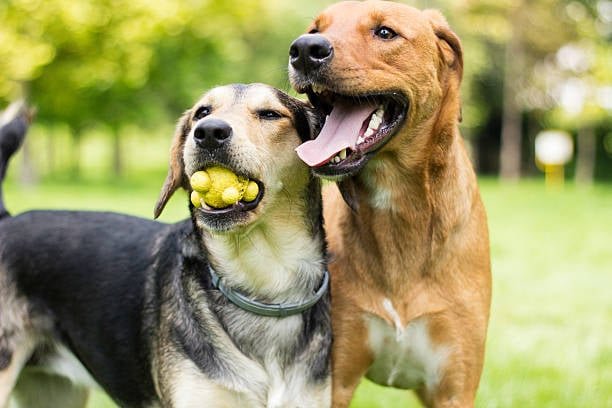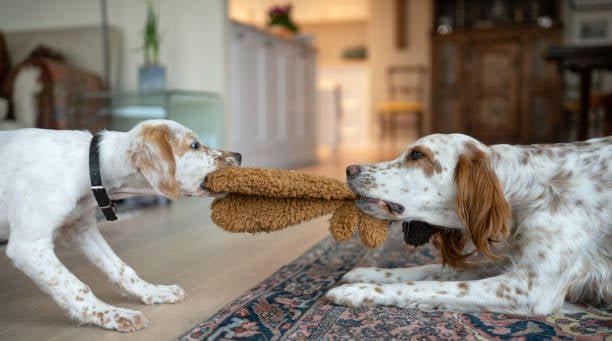In general, the introduction of two male dogs can be quite problematic but at the same time, know-how of it might seem rather useful. Introduction should also be done in the proper way in order that no conflict may occur and to make a good relationship with the new dog. When it entails structured procedures like beginning the session at the ‘neutral ground’ and focusing solely on the positives, then the encounter will be a peaceful one for both the dogs. This guide will give some tips on how to introduce two male dogs together and make it safe and as comfortable for the dogs as well as everyone else.
Why Introducing Two Male Dogs Can Be Tricky
Male dogs require more training compared to female dogs, and unplucked dogs are even more problematic because they can get territorial and display dominance. These behaviors are not so much behavioral as they are instinctual as the animals are trying to lay down their territories and claim their dominance in a specific pack. These instincts can come out as aggression, anxiety, and battles for the almighty position between two male dogs if those two male dogs are suddenly introduced to one another without due consideration. Further, the character of every dog and their past experiences cause differences in the way they greet new friends. Therefore, the introduction process requires precise planning and increases the time needed for it.
The Importance of Proper Introduction
In this case, the most important segment is the introduction in order to create a favorable impression between the two male dogs. It is noteworthy that, when introducing the dogs, some actions are effective in preventing host conflicts or making the dogs feel secure. This enables them to familiarize themselves with each other’s presence and feel in a constructive and safe process that makes for a good start towards the absence of any-intensity conflict. Owning the time to appreciate each dog’s conduct and then start to introduce them in territories where both dogs are comfortable are the main paths that the owners should follow so that they can uphold a respectable environment. What is more important is the fact that it helps protect the dogs and order in the family at the same time.
Male Dog Behavior
Male dogs often exhibit distinct behaviors compared to females. They tend to be more territorial, marking their space and guarding it protectively. Dominance is also more pronounced in males, often displayed through posturing and assertive behavior. Play styles can be rougher, sometimes mistaken for aggression. Factors influencing these behaviors include dominance hierarchies, territorial instincts, socialization experiences, age, and past interactions with other dogs. Understanding these nuances is crucial for managing male dogs effectively.
Assessing Individual Temperament

Before introducing two male dogs, it is imperative to thoroughly assess each animal’s temperament. This evaluation involves observing their behavior in various settings, such as interactions with people, other animals, and unfamiliar environments. Prior experiences with other dogs, particularly the outcome of those interactions, provide valuable insights into their social tendencies. Additionally, consider each dog’s energy level and preferred play style, as compatibility in these areas can significantly influence the success of the introduction process. Recognizing early signs of aggression, such as growling, stiff posture, or snapping, as well as anxiety indicators like trembling, panting, or avoidance, is essential for proactive management during the introduction phase.
Initial Meeting and Introduction
The first meeting between two male dogs should occur in a neutral environment to minimize territorial tensions. Choose a quiet, distraction-free location like a park or a friend’s yard.
Both dogs should be securely leashed and harnessed for safety and control. Begin with brief, supervised encounters, allowing them to observe each other from a distance. Maintain a calm demeanor and reward positive behaviors with treats and praise.
Monitor their body language closely. Positive signs include relaxed postures, wagging tails, and playful interactions. If either dog exhibits aggression (growling, stiff body language, or staring), calmly separate them and try again later. Gradually increase the duration of supervised interactions as they become comfortable.
Introducing Dogs When One is Aggressive
Introducing a new dog to a resident aggressive dog requires careful planning and patience. Here’s a step-by-step approach:
- Assess the aggression: Understand the triggers and severity of the aggressive behavior. Consult a professional trainer if needed.
- Prioritize safety: Use muzzles, crates, or baby gates to ensure the safety of both dogs during the introduction process.
- Choose a neutral environment: Introduce the dogs in a calm, distraction-free area to minimize territorial tensions.
- Gradual exposure: Begin with controlled interactions, allowing the dogs to see and smell each other from a distance. Gradually increase proximity as they tolerate it.
- Positive reinforcement: Reward calm behavior in both dogs to create positive associations.
Seek professional guidance: Consult a qualified trainer or behaviorist for personalized advice and support.
Introducing a New Dog to an Existing Household
Integrating a new dog into a home with a resident aggressive canine requires careful planning. Prioritize safety by thoroughly pet-proofing the living space. Create distinct areas for each dog, using gates or separate rooms to establish personal territories. To facilitate gradual acclimation, introduce the dogs to each other’s scents through shared bedding or toys. Ensure ample resources, such as food and water bowls, are available for both animals. Finally, designate quiet “safe retreats” where each dog can relax undisturbed.
Supervised Interactions
Start with brief, supervised interactions in a calm environment. Keep both dogs on leashes and reward calm behavior with treats and praise. Gradually extend the duration of interactions as they grow more comfortable. Always monitor body language closely, separating dogs if signs of stress arise. Engage them in shared activities to foster bonding.
Introducing Intact Male Dogs
Intact male dogs can present unique challenges due to hormonal influences. They may exhibit increased territoriality, dominance, and mating behaviors. To manage introductions, maintain close control in a neutral environment, provide ample exercise, and use gradual, positive reinforcement methods. Ensure each dog has its own space and consider professional guidance if needed.
Introduction Techniques for Intact Male Dogs
Introducing intact male dogs requires extra caution. Here are some strategies:
- Gradual Exposure: Start with controlled, supervised interactions, allowing dogs to see and smell each other from a distance. Gradually increase proximity as they become comfortable.
- Neutral Territory: Choose a neutral, distraction-free environment for initial meetings to avoid territorial disputes.
- Leash Control: Keep both dogs on leashes during introductions to maintain control and prevent sudden confrontations.
- Avoid Triggers: Remove potential triggers like toys or food to minimize resource guarding and competition.
- Positive Reinforcement: Encourage calm behavior by offering treats and praise, building positive associations.
- Separate Spaces: Ensure each dog has its own safe space to retreat to when needed.
Remember, introducing intact males can be challenging. Patience, close supervision, and professional guidance may be necessary for a successful outcome.
Living Together Peacefully
Maintaining a harmonious relationship between two male dogs requires ongoing attention and management.
- Consistent Training: Continue regular training sessions to reinforce good behavior and strengthen your leadership role. Incorporate group training exercises to promote cooperation and teamwork.
- Dedicated Bonding Time: Spend quality one-on-one time with each dog to prevent jealousy and strengthen individual bonds. Engage in shared activities and playtime to foster a strong relationship between the dogs.
- Monitor for Changes: Continuously observe your dogs’ interactions for signs of stress, aggression, or changes in behavior. Address any issues promptly.
- Create Retreat Spaces: Provide each dog with a designated quiet area where they can relax undisturbed.
- Prevent Resource Guarding: Feed dogs separately and gradually introduce shared resources under supervision. Consult a trainer if issues arise.
- Manage Dominance and Submissiveness: Establish a clear hierarchy with you as the pack leader. If imbalances cause problems, seek professional guidance.
- Address Anxiety and Fear: Create a calm environment and consider professional help for dogs exhibiting excessive fear or anxiety.
- Seek Professional Help: If aggression persists or you feel overwhelmed, consult a qualified dog trainer or behaviorist.
Establishing Boundaries and Routines
Consistent rules and routines provide structure for your dogs. Implement clear household rules, such as designated sleeping and feeding areas. Maintain a regular daily schedule for meals, walks, and playtime. Incorporate training sessions to reinforce good behavior and establish your leadership. By creating a predictable environment, you help your dogs feel secure and reduce potential conflicts.
Troubleshooting Common Issues
While introducing dogs can be rewarding, challenges may arise. Recognizing and addressing problems promptly is essential.
Common Challenges and Solutions
- Resource Guarding: If either dog shows possessiveness over food, toys, or sleeping areas, consult a professional trainer. Gradual exposure to shared resources under supervision can help.
- Dominance and Submissiveness: Imbalances can lead to tension. Consult a trainer to establish a clear hierarchy with you as the pack leader.
- Anxiety and Fear: If a dog exhibits excessive fear or anxiety, create a calm environment and seek professional guidance. Gradual desensitization techniques can be helpful.
- Redirected Aggression: If a dog redirected aggression towards a human due to frustration with another dog, address the root cause and provide ample exercise and mental stimulation.
- Persistent Aggression: If aggression continues despite efforts, consult a professional dog behaviorist immediately.
Professional Help: Understanding Your Options
When introducing male dogs, it’s essential to know when and where to seek professional help. Understanding the different types of professionals available can guide owners in making informed decisions.
- Dog Trainers: Focus on basic obedience, behavior modification, and socialization. They can help with general training and addressing minor behavioral issues.
- Behaviorists: Specialize in complex behavioral problems, such as aggression, anxiety, and phobias. They can provide in-depth assessments and develop tailored behavior modification plans.
Veterinarians: Can rule out medical causes for behavioral issues and offer medical management options if necessary. They can also recommend specialists if needed.
When to Seek Professional Help
Seek professional guidance if:
- Persistent aggression or reactivity: If dogs consistently show aggression towards each other, professional intervention is crucial.
- Fear or anxiety: Excessive fear or anxiety can hinder the introduction process. A behaviorist can help develop desensitization and counterconditioning plans.
- Medical concerns: If there are underlying medical issues affecting behavior, veterinary consultation is essential.
Remember: Patience, consistency, and positive reinforcement are crucial. With careful management and, if necessary, professional support, you can create a harmonious multi-dog household.
Breed-Specific Considerations
While the general principles of dog introduction apply to all breeds, certain breeds may exhibit specific tendencies.
- Dominant breeds: Breeds like Rottweilers, German Shepherds, or Dobermans may display strong territorial instincts and dominance behaviors. Careful management and professional guidance are often necessary.
- High-energy breeds: Breeds like Border Collies or Jack Russell Terriers have high energy levels. Providing ample exercise and mental stimulation can help reduce tension during introductions.
Shy or anxious breeds: Breeds like Greyhounds or Whippets may be more cautious and fearful. Creating a calm environment and gradual introductions are essential.
Conclusion
Introducing two male dogs requires patience, understanding, and a structured approach. By following the guidelines outlined in this article on how to introduce two male dogs and paying close attention to your dogs’ behavior, you can increase the chances of a successful and harmonious coexistence. Remember, every dog is unique, and it may take time for the dogs to adjust to each other. If you encounter challenges, don’t hesitate to seek professional help.












